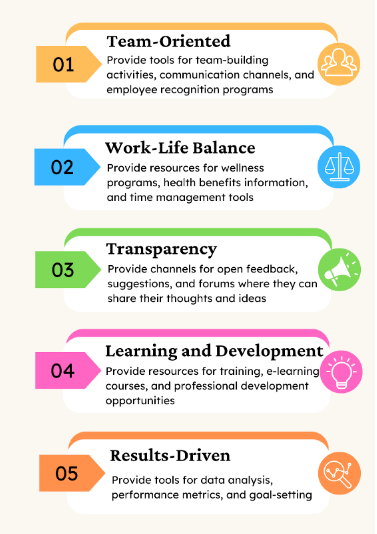A study by McKinsey Global Institute found that the productivity of knowledge workers improves by 20-25% in organizations where employees are connected through an effective communication and collaboration platform such as an intranet.
An intranet is a private network or system that is accessible to an organization’s employees, contractors, and stakeholders. It is a centralized platform that hosts internal communication tools, collaboration tools, and resources, such as documents, policies, procedures, and company news.
The intranet serves as a reflection of a company’s culture and values, making it essential to design one that aligns with its mission and vision. To design an intranet that reflects your company culture and values, there are specific steps you need to follow.
In this article, we will explore those steps and provide guidance on how to develop content and measure the impact of your intranet. We will also include facts, trivia, and statistics to illustrate the importance of intranets and how they impact company culture and employee engagement.

Understanding Your Company Culture and Values
Understanding your company culture and values is essential when designing an intranet that accurately reflects your organization. Your company’s culture represents its personality, beliefs, and values; incorporating these elements into your intranet design is crucial.
Start by analyzing your company’s mission statement and core values to identify key themes that can guide your design decisions. Consider the tone and style of your company’s communications and ensure that your intranet reflects this.
Identify your company principles. What are the steering principles of your organization? What do you stand for as a company? Understanding your core principles will help you develop content that reinforces those values.
Aside from identifying your company’s guiding principles, comprehending your organization’s culture is vital. A company’s culture refers to the collective attitudes, beliefs, behaviors, and values that determine how employees collaborate and work together.
Check the image below and take it for inspiration to determine how to reflect the company culture and values in the intranet design.

Developing Content for Your Intranet
Once you clearly understand your company culture and values, the next step is to develop a content strategy that supports these values.
Here are some tips for developing content for your intranet that reinforces your company culture and values:
- Use storytelling to reinforce your culture: Stories are a powerful way to convey your company’s culture and values. Consider sharing stories about employees who embody your company’s values or highlighting examples of how your company has made a positive impact in the community. According to a recent study, people love videos that tell a story, so consider creating videos for your intranet.
- Encourage employee contributions: Your employees are your greatest ambassadors for your company culture and values. Encourage them to contribute content that reflects their experiences and perspectives. For instance, you could create a blog where employees can share their thoughts on industry trends or company initiatives.
- Make it engaging: The more engaging your content is, the more likely it is to be read and shared. Consider using multimedia elements like videos, images, and infographics to make your content more engaging. You can even create a video on Instagram, download it, and post it on your company’s intranet. Who wouldn’t like to view those aesthetic and creative IG stickers?
- Create a content calendar: Develop a content calendar that outlines the topics and themes you will cover on your intranet. Be sure to include key dates such as company events, holidays, and other important milestones. This will keep you organized and ensure you deliver relevant content to your employees regularly.
Related Topics:
- Intranet Communications – Driving Staff Communication and Collaboration
- Intranet Analytics & Reporting: The Full Guide
- 4 Reasons Why No One Uses Your Company Intranet
Measuring the Impact of Your Intranet
The final step in designing an intranet is to measure its impact. But how and why should you measure your intranet’s progress?
Companies can use SharePoint analytics to measure the effectiveness of their intranet. You can gather valuable insights into how your intranet is being used and where you can improve if you track metrics such as page views, unique visitors, time spent on a page, and search queries.
You can also measure your content strategy’s effectiveness and identify improvement areas. Say, you posted a free tutorial on your intranet, and it received a high number of views and positive feedback from your employees. This indicates that your employees are interested in learning and growing, and you can use this information to create more content that supports their professional development.
Conversely, if certain pages or content receive low engagement, you can evaluate whether they align with your company culture and values or if they need to be reworked to better meet the needs of your employees.
Aside from monitoring intranet metrics, you can also obtain firsthand feedback from your employees through conducting surveys and feedback sessions. This method offers a more holistic comprehension of how your intranet is viewed by those who use it frequently. You can also use employee feedback to authenticate your hypotheses about what’s working and what’s not and to generate new ideas for improving your intranet.
Summing It Up
A successful intranet project is not a small effort, but it’s definitely achievable once you set your goals, plan for time and budget appropriately, and stick to your timeline. There are different elements to consider when designing and implementing your intranet, but understanding your company culture and values can help guide the decision-making process.
As you identify the goals you want to achieve with your intranet, creating a content strategy will help ensure that the content you develop reinforces and aligns with your company values. Likewise, mapping out the success metrics for your project will help ensure that you measure whether or not those goals have been achieved.
Check CardioLog’s SharePoint Portal/Web Analytics platform, as it provides comprehensive insights and real-time data analysis of your intranet usage, including Microsoft 365 analytics. By leveraging these metrics, you can optimize your intranet’s effectiveness and identify areas for improvement, making data-driven decisions that help your employees and company achieve their goals.



 Follow @cardiolog
Follow @cardiolog 